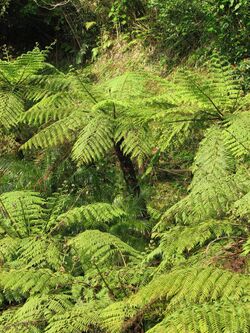Biology:Alsophila spinulosa
| Alsophila spinulosa | |
|---|---|

| |
| Scientific classification | |
| Kingdom: | Plantae |
| Clade: | Tracheophytes |
| Division: | Polypodiophyta |
| Class: | Polypodiopsida |
| Order: | Cyatheales |
| Family: | Cyatheaceae |
| Genus: | Alsophila |
| Species: | A. spinulosa
|
| Binomial name | |
| Alsophila spinulosa (Wall. ex Hook.) R.M.Tryon[1]
| |
| Synonyms[1] | |
| |
Alsophila spinulosa, also known as the flying spider-monkey tree fern, is a species of tree fern in the family Cyatheaceae.[1]
Description
The trunk of this species can grow to a height of 5 m or more. The stipes are persistent, spiny and purplish towards the base, and covered in brown shiny scales. Fronds are 1–3 m long and three-limbed. The sori, producing the spores, are large and round. Like many tree ferns, it features a "skirt" of dead leaves that do not drop off the crown and form a barrier for parasitic climbing plants.[2]
Distribution and habitat
A. spinulosa occurs in humus soils in shadowed forest locations, and is widely distributed across Asia including China, Nepal, India, Burma, Myanmar, and Japan.[3][2]
Use by humans
The stems are rich in starch and edible. Stem chips also see use as fern chips as a substrate for the cultivation of orchids.[2]
Genome
In May 2022, the genome of A. spinulosa, was sequenced by Huang et al. and showed whole-genome duplication had occurred approximately 100 million years ago; since then, evidence of the sequencing suggests, the genome has remained stable.[4][5] It was only the third time a fern's entire genome had been entirely mapped, and the first instance of a fern with a genome of this size being sequenced.
Gallery
References
- ↑ 1.0 1.1 1.2 Hassler, Michael; Schmitt, Bernd (June 2019), "Alsophila spinulosa", Checklist of Ferns and Lycophytes of the World, 8, https://worldplants.webarchiv.kit.edu/ferns/, retrieved 2019-08-20
- ↑ 2.0 2.1 2.2 T. C. Huang, ed (1994). Flora of Taiwan. 1 (2nd ed.). Taipei: Editorial Committee of the Flora of Taiwan. pp. 148.
- ↑ "Cyathea spinulosa Wall.". Species 2000: Naturalis, Leiden, the Netherlands. https://www.catalogueoflife.org/data/search?q=Cyathea+spinulosa&type=EXACT. Retrieved 17 March 2017.
- ↑ Huang, Xiong; Wang, Wenling; Gong, Ting; Wickell, David; Kuo, Li-Yaung; Zhang, Xingtan; Wen, Jialong; Kim, Hoon et al. (May 2022). "The flying spider-monkey tree fern genome provides insights into fern evolution and arborescence" (in en). Nature Plants 8 (5): 500–512. doi:10.1038/s41477-022-01146-6. ISSN 2055-0278. PMID 35534720.
- ↑ Whang, Oliver (2022-09-12). "Cracking the Case of the Giant Fern Genome" (in en-US). The New York Times. ISSN 0362-4331. https://www.nytimes.com/2022/09/12/science/fern-genetics-polyploidy.html.
External links
Wikidata ☰ {{{from}}} entry
 |





